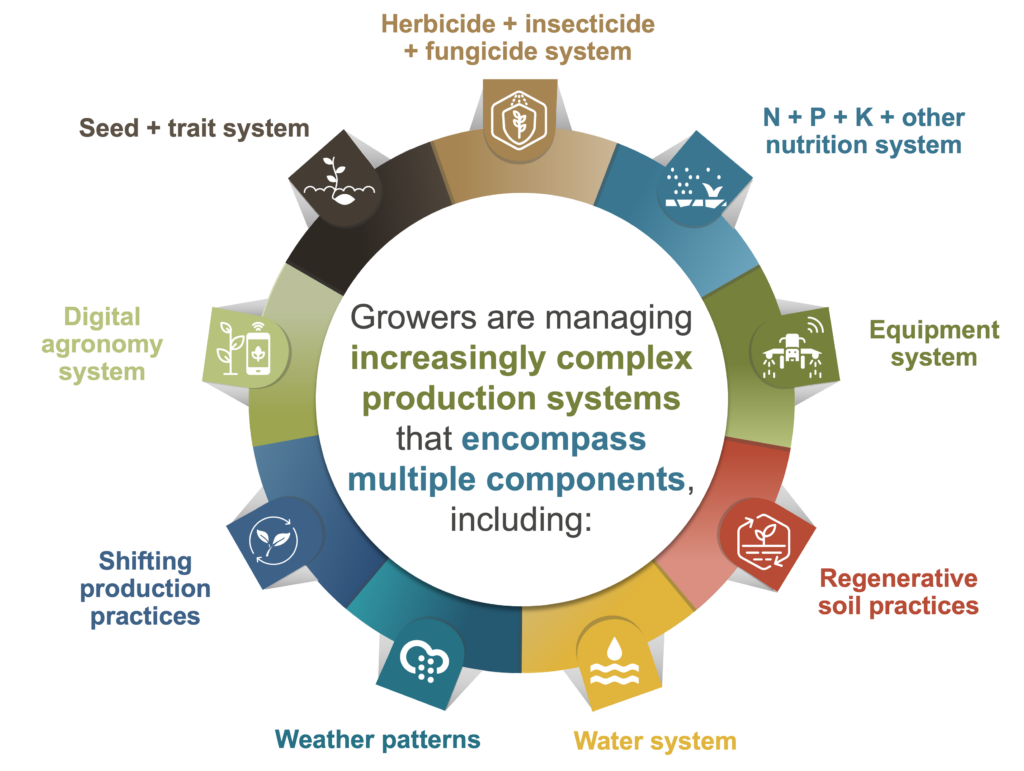As complexity increases, driving outcomes—not products—may improve adoption.
This is the second article in a series exploring business model innovation through risk mitigation across the agriculture value chain. In the December 2022 article, Christian Guffy, a partner with The Context Network, discussed the historic compartmentalization of risk and the potential for risk sharing in commoditized product categories. This month, Guffy shares his perspective on risk sharing in a very different kind of market environment—one in which the pace of product innovation is accelerating.
The extent of innovation in the agriculture industry today is exciting. Advancements in biologicals, satellite imagery, variable rate technologies, and other equipment types are making agriculture production more precise than ever before.
From a grower’s perspective, however, more precision also means more complexity—and therefore more interdependent risks. Growers may appreciate the potential benefits of an innovative new product or technology, and yet opt to sit on the sidelines until its outcomes are proven and resilient. Even if a product shows demonstrable benefits, growers may hesitate to disrupt the rest of their production “recipe” by adding a new “ingredient.” This wait-and-evaluate approach isn’t new; it has long slowed the uptake of new products and technologies, and the ag industry is no less immune to this reality today.
It’s important to understand that while most companies and providers that growers work with are narrowly focused on select component(s) of a broader system, growers see everything through a wide-angle, systems-based lens. Growers consider a wide range of factors that go into a successful crop, such as soil conditions, weather cycles, equipment use and chemicals applications. A new product isn’t evaluated in isolation; it is evaluated as to whether it will help solve a production challenge or improve production outcomes. Take, for example, a grower who is considering whether to make a significant capital expenditure on a new precision sprayer. The complexity of new technology is amplified by the myriad of other products and practices used in the grower’s system. In short, the question on the grower’s mind is actually quite simple: will it get rid of my weeds? Growers don’t need another tool, necessarily. They need to know if the tool solves a problem—without creating other problems.

Driving novel product adoption through value chain integration
In a production environment with increasing variability and complexity, upstream agriculture companies can speed adoption of innovative products by delivering not just a product but a cohesive system approach that seeks to mitigate growers’ risk. This approach focuses less on the product itself and more on the outcome that growers will achieve through its adoption. Going back to the example of a new precision sprayer, for instance, a company may offer a solution that guarantees a weed-free field when growers use the sprayer in conjunction with a set of compatible products and/or services. The integration of multiple components addresses growers’ need: no weeds. And by offsetting some of the risk of early adoption with growers, companies establish themselves as being equally invested in production outcomes as the growers themselves.
Sharing in the risk of new innovations may provide a much-needed boost to the historically lagging adoption curve in production agriculture. As the pace of innovation continues to accelerate, the ability to earn growers’ loyalty and be a more integral production partner may prove critical. Beyond the tipping point of adoption, however, the jury is out on growers’ desire to share risk into perpetuity. Growers—as business owners in a capital-intensive and cyclical industry—are inherent risk takers. Therefore, risk sharing may only prove to be an entry point for technology adoption, with growers shifting to a more arms-length transactional relationship once technologies are proven.
It’s important to acknowledge that this kind of risk sharing may not be right for every company. You can’t reasonably take on outcome risk unless you own some degree of control over the many complex variables in growers’ production systems. Therefore, it would be difficult for product-driven companies alone to execute. A la, partnerships across the value chain.
Properly managing on-farm risk will take collaboration between different entities who can contribute to various facets of the outcome, from seeds to services to equipment. The level of cohesion required to align multiple companies and providers to a singular goal is inherently difficult, but we are starting to see the fruits of this integration effort across production agriculture. Processors, OEMs, ag retailers, technology providers, oil companies, seed providers, crop protection innovators, fertilizer producers, etc. have all made notable partnership announcements in recent months, signaling a recognition that system and value chain integration is needed to fully enable on-farm impact. Hopefully this will yield meaningful and faster adoption of products and practices that drive better food and agriculture outcomes.
I encourage you to consider how a risk-sharing strategy (or not pursuing one) that focuses on a systems approach might align with your organization’s business goals and how it would impact your business relationships.
Ask yourself if these enabling factors are in place:
- Do we have existing relationships with growers?
- Do we have access to the products?
- Who else should be part of this collaboration?
- Do we have growers’ trust and confidence to access their data?
- What is the quality of historical data to validate production practices?
- What is the quality of data to accurately attribute crop outcomes?
Our team at The Context Network understands a range of risk-sharing approaches to help incentivize product adoption in high-innovation categories. Through our business know-how and broad network of specialized experts, we can help you evaluate opportunities and craft appropriate strategies. To discuss what these new models could look like for your business, please reach out to me at christian.guffy@contextnet.com.
Christian Guffy, Partner, brings experience in consulting, strategy development, and financial analysis in a variety of industries including agribusiness, investment finance, and retail. He has helped clients develop long term strategic plans as well as annual go to market strategies rooted in fundamental market analysis and research. He has also advised companies on corporate financial planning including capital expenditures, business unit divestitures, and strategic acquisitions. As a result of these client engagements and his prior experiences, Christian is well suited to engage clients in pursuit of their overarching business objectives.


